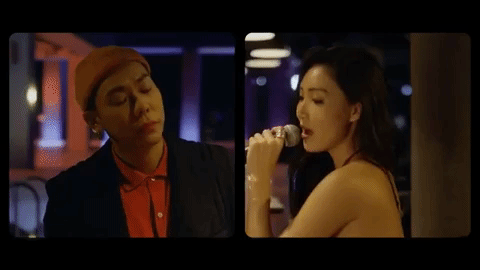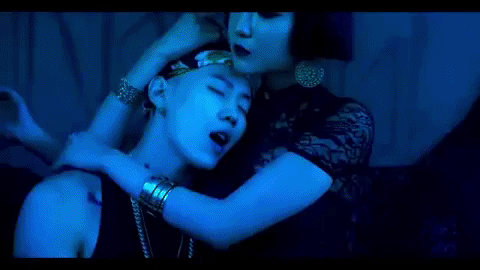FROM THE BRONX TO SEOUL: AN ANALYSIS OF POPULAR SOUTH KOREAN HIP-HOP AND RAP MUSIC VIDEOS
BY RICKY RATH
DISCUSSION
There were a lot of expected outcomes but also a handful surprises that came from the results. Prior to this study, I’ve only listened to Korean hip-hop and rap briefly, typically only the hit songs that grow popular in America but through this study I was able to immerse myself into their music and entertainment industry. Here is a breakdown and analysis of the findings.
MATERIALISM
In nearly every video, rappers were seen sporting either street-wear brand or designer brand clothing along with flashy jewelry. I predicted this as the dominant visual content among other categories. Conrad, Dixon, Zhang (2009) stated this theme was developed from 1993, where rap music was more likely to to contain images and reinforcement of consumption. Within the videos coded, materialism was not typically seen in action, but instead framed as a statement of the rapper’s wealth and status. According to the Associated Press, in 2014, Pope Francis held mass in South Korea and addressed his concerns over the potentially dangerous culture of materialism. Yes, that’s how serious it was. South Korea rapidly became one of the economic powerhouses in the world which has ultimately planted a seed for materialism as a way to show off wealth thus making it important to rappers.
“Come Here,” by Masta Wu was the most outstanding example of high materialism. This cypher-styled song on the major label, YG Entertainment, featured dozens of scenes of rappers with gold chains, watches, grills, a mix of street-wear and designer brand clothing. Along with that, rappers are seen “flexing” or “stunting,” their assets of cars and money. Out of the 28 videos, I would say this video was the closest one to American music videos with their content of materialism, aggressiveness, and misogyny. They attempted to imitate the “thug” narrative from American rap with numerous scenes of intimidation and masks but it still left me with questions of their authenticity.

GIF FROM "COME HERE"- MASTA WU
DRUGS & ALCOHOL
I was familiar with South Korea's culture of drinking and expected this to be common throughout videos but I was more interested in examining their references to drugs. Drugs laws are strict within South Korea and a number of Korean artists have been arrested for marijuana use including one of the rappers featured in the “Loser” music video by Big Bang, reported by Billboard. I believe labels play a major role in restricting the visuals and references
of drugs as it may be a liability for their company and artists. In "You Know,”
by Jay Park and Okasian, I was surprised to see Okasian openly smoking a
marijuana joint multiple times. Both artists have crossed-over into American
markets and may have been attempting to appeal to American audiences.
I noticed alcohol was represented in three different ways. Alcohol would be
featured either as an accessory to partying, or symbol of wealth through
highly expensive drinks, or featured to help tell a narrative in the video. I
thought the last point was interesting as I saw different ways alcohol was
used to tell a story such as in “Don’t” by Loco and Hwasa, where both artists
are seen at a bar rapping and singing about alcohol drinks and its role on
their past experiences of meeting people at bars. According to the World
Health Organization, South Koreans are ranked number 13 in alcohol
consumption and number one in hard liquor consumption. Drinking culture
in Korea consists of several social etiquette and norms which leads me to
understand why alcohol is an important visual within their music videos.

SOJU, KNOWN AS KOREA'S MOST POPULAR ALCOHOLIC DRINK. PHOTO FROM KOREANWINE.COM
VIOLENCE
General actions of violence were very limited. When they were featured in videos, they were often paired to help advance the video’s narrative such as in “Loser” by Big Bang. The video depicts the group’s insecurities and pressures under the spotlight paired with the emotionally charged lyrics. Throughout the video, the rappers star in personal scenarios from their life which includes one of them being bullied and beaten in the street. It was definitely the most powerful song from the batch I coded.
I think the fact that guns weren’t typically displayed or flashed was because there isn’t a “gun culture” in South Korea. The firearm regulation is categorized as restrictive, as reported by Gunpolicy research. As of 2016, the number of licensed gun owners was at 138,751 and the numbers have continued to drop since 2007, according to Gunpolicy research. USA Today’s article on the 2018 Winter Olympics’ security is good report bringing this to life. Security for the event was described as “low-key” and didn’t consist of the usual heavily armed police seen in previous Olympics. The article reported officials said this reflected the low levels of violent crime in the country. In a population of 51 million, there was only 356 homicides in 2016 reported by South Korea’s National Police Agency. Wow.
Where American rappers are commonly seen flashing guns in videos to intimidate rivals, this is not common in Korean hip-hop and rap as they can’t and don’t have a reason to. Several of the music videos I coded were groups and cypher-styled collaborations, leading me to suggest most rappers are in good relations with each other.
MISOGYNY
As a continuous theme in hip-hop and rap music throughout its existence, I feared misogyny would be adopted by Korean music. Although this was the second most dominant visual content, I discovered Korean’s featuring of misogyny was often light and far-less extreme. Women were often used to help set the scene of a party with them suggestively dancing and dressed in revealing clothing. Interestingly, misogynistic scenes were often featured more often in major record labels. I analyzed this as the label’s ability to hire more women as extras to feed into the rappers’ images of attraction, creating the perception their rappers are wanted by dozens of women.
If women weren’t dancing in bikinis in the background of rappers, they were subtly featured sitting or laying in the background as a way to improve the visual appeal of the video. In “Iffy” by Sik-K and pH-1, the cast of women are seen sleeping and laying down after what appears to the day after a party. The women are also seen in several suggestive eating scenes. When the video arrives to Jay Park’s verse, a woman is seen wearing a paper bag with Park’s head photo on it because he couldn’t make it to the video shoot. This video particularly was a prime of example of how women are objectified without having to be half-naked or pretend to lust over the rapper. Although a fun poppy video, this is how some music videos avoid pushing the gas pedal on extreme misogyny.
LOVE & RELATIONSHIPS
Expressions of love and emotions was the least dominant visual content but that was expected as hip-hop and rap is often a hyper-masculine act. More interestingly, I found love to be more prevalent in independent labels. I thought major labels would have a higher interest in themes of love and relationships but I believe they have less interest in it because the major labels are obsessed with crafting and presenting their artists as cool superstars. Rapping about narratives of a broken heart or past relationships would take away their superstar credibility. Rapping on a smaller label may allow artists to freely express themselves.
A few of the videos featuring love related themes starred a male and female artist and the song structure was set-up as a call and response. I thought this was pretty interesting because I don’t see too much of this in American hip-hop and rap anymore as it used to be popular in the early to mid 2000s. I appreciated this because it adds another layer to the song and offers us a female perspective especially in what can be a male dominated industry. As stated earlier, “Don’t” by Loco and Hwasa is about a man and woman meeting at a bar for the first time and are interested in each other. The entire video is set in an empty bar with them trading verses and even a duet at the end. If Korean hip-hop and rap music can continue to bring in elements of love, emotions, and relationships, they have a high potential of creating a unique footprint in the genre.


"Don't offer me a drink, oh baby.
It will only bring regrets.
Don' give me courage, oh baby.
I know it will last a day."
"Men are all the same.
No, men who had drinks are all the same.
Saying I don't see anyone but you
is saying I forgot everything else but you"
HWASA IN "DON'T"
LOCO IN "DON'T"
LYRICAL THEMES
Most of the visual content paired together with the lyrics of the songs. Since a high number of the videos were set in party or social gathering situations, it validates alcohol as the top theme feeding into South Korea’s drinking culture. When videos weren’t set at parties, they were set at gritty locations such as warehouses. A lot of these videos featured lyrics involving braggadocio, where rappers boast about their raw ability as an emcee. Sex and love were often related to one another in the lyrics but there were times love would be mentioned without sex. A lot of the songs involved the male rapper admiring a female love interest.
The most interesting pull away from the lyric to video analysis was the odd connection between love and misogyny. “Peach” by Reddy and “You Know” by Jay Park both featured several misogynistic scenes. In “Peach,” Reddy raps about his admiration for his love interest in the video but is surrounded by women dressed in bodysuits performing tasks for him in the background. In “You Know,” women are seen spinning on stripper poles lusting over the rapper with brief flashes of one specific woman in slow motion. After decoding the lyrics, Jay Park was rapping and singing about missing his ex love interest and her sex. These examples create a strange mashed narrative of love and misogyny where no matter how many women the rapper attracts, it isn’t the same as their love interest. I can see this as a way to protect the rapper’s masculine image while also showcasing an emotional side. This can be incredibly misleading to non-Korean viewers if captions aren’t shown.
"The memories and experiences we've shared
keep crossing my mind.
I'm drinking water as well but I'm still thirsty.
My memories are fading, refresh my memory
tonight."

JAY PARK IN "YOU KNOW"
PARK PROTECTS HIS MASCULINITY BY RAPPING AT A CLUB SURROUNDED BY OTHER WOMEN WHILE SIMPIN' ABOUT HIS EX.
GLOBALIZATION & CULTURAL HYBRIDIZATION
After my research, it is clear to see how globalization has helped send American hip-hop and rap rooted themes discussed in Conrad, Dixon, and Zhang’s (2009) work to South Korea. After exposure of Western hip-hop culture, Koreans began adopting elements from Americans in their music lyrically and visually. As trends change in America, I see that Koreans are able to quickly adapt to what is popular to Western culture. This is all credited to the worldwide web. Through the internet, Koreans are able to watch international music videos hosted on Youtube and catch onto what’s hot. While I was browsing through other Korean music videos, there were numerous times I can specifically pinpoint the American rapper that has inspired them. This can lead to an identity crisis for Korean hip-hop and rap.
Cultural hybridization is growing more apparent as globalization has allowed different cultures to intersect. Throughout the videos I coded, a large number of them featured English phrases or references and when I scrolled down to the comments there are a mix of Korean and English user comments. “It G Ma” by Keith Ape was a collaboration between Korean and Japanese rappers. It instantly blew up in America and months later received an official remix starring Keith Ape with American rappers. As Korean artists work toward creating a distinct identity, it is still clear they have participated in evolving hip-hop culture and creating a new form of it. This type of crossover between cultures creates a connection from consumers and performers in Korean to those living in America, the house of hip-hop and rap culture.
NEGATIVE AND POTENTIALLY HARMFUL ELEMENTS
The heavy emphasis on materialism can prove to be detrimental for future generations of Koreans. This could create pressure among Korean teens to feel the need to purchase expensive brands of clothing in order to fit in at school or look cool. South Korea is a fiercely competitive country for individuals aspiring for success and this high pressure has contributed to the highest rate of suicides for a developed country, according to the Associated Press. Among my research, I can infer Koreans deeply care about their image and this struggle to keep their image in high status combined with the country’s high consumption of alcohol can create harmful scenarios.
As I was analyzing the women featured in the music video, I noticed a high amount of light-skinned thin women casted into the videos. There was little representation of women with other body figures or skin tones. In a country absorbed by a culture of materialism, the presented beauty standards showcased in hip-hop and rap music videos further heighten society pressures. South Korea holds the highest per capita rate of cosmetic surgery in the world with one in three women between the ages of 19 and 29 going under the knife, according to NPR. The women presented in Korean hip-hop and rap music videos can create self-esteem issues especially among Korean teens who may look up to these mega-stars.
Lastly, there were numerous instances of black cultural appropriation from the music videos. Since Koreans are performing under a culture rooted from black communities in New York, they have to understand the line between inspiration and appropriation. An example of this can be seen through hairstyles and the use of durags. The Koreans rappers may be trying to look cool or fit in with other black rappers but it opens a gate to cultural abuse from their fans who look up to them. America fans haven’t been shy of voicing out their feelings of cultural appropriation in Korean music including Big Bang rapper, G-Dragon who was criticized for use of black face (Oh, 2014.) Korean music consumers must continue to critically address cultural appropriation issues within the genre in order to help record labels and artists understand their mistakes.